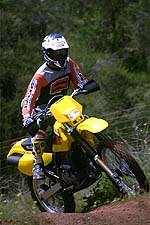Church of MO: 2001 Suzuki DR-Z250
Did September 11, 2001, change the world? Seems like it did, beyond the destroyers of the World Trade Center’s wildest dreams. Before that, there was Minime and Calvin off for a ride on a spring day on a new Suzuki DR-Z250. After that, things got somber: You had to take off your shoes to fly, and deal daily with a whole new level of amorphous paranoia. Oh well. Suzuki sold the DR-Z250 in the US right up until 2019. Most of them are still blatting along on a trail near you – just the antidote you need to tune out the cray-cray.
Suzuki Introduces the U.S. to a Japanese Favorite
Torrance, California, April 17, 2001 — We were a bit shocked when we found out about the new DR-Z250 a few months ago. You see, with media attention trained on bikes like Yamaha’s YZ250F and the new moto thumper that Honda is set to debut at the Glen Helen Nationals very soon, we couldn’t help but question Suzuki’s motives in bringing out a 250 trail bike.The DR-Z seems well-equipped to go up against the likes of Honda’s XR250 and maybe even Yamaha’s TTR-250. It has been selling well in Japan since 1996, but does the US market really need another trail bike?
Suzuki thinks it does. And to that end, their new
250 comes in as an entry-level off-road bike that has a few nice bits on it, though nothing truly innovative. Then again, as a beginning off-road rider, you’re more concerned with ease of use and reliability for years to come. To that end the Suzuki has a few nice touches such as electric start, a low seat height and adjustable suspension, but will that be enough to make people want the bike?Tech Inspection At the heart of this new Suzuki is a wet-sump DOHC 4-valve, air/oil-cooled motor. It features Suzuki’s TSCC (Twin Swirl Combustion Chamber) cylinder head and even a balancer shaft for smooth running, just like its big brother DR-Z400. The motor’s power comes courtesy of its 249 cc displacement via 73.0 x 62.6 mm bore and stroke figures. The mid-sized motor also features a 10.4:1 compression ratio and a six-speed gearbox.
The motors in 49-state bikes get their fuel/air mixture from a 28 mm Mikuni carb while California versions get a special 32 mm Mikuni that meets California’s “green sticker” requirements. Oil temperature is kept in check thanks to an air-cooled oil cooler that directs its contents to a cooling chamber in the cylinder.The cylinder itself is made of aluminum and features Suzuki’s SCEM (Suzuki Composite Electro-chemical Material) finish. This nickel-phosphorus-silicone-carbide finish is supposed to be very light and durable, ensuring long life and cool running temperatures even under heavy loads.
Power makes its way to the rear wheel thanks to a 13-plate clutch that uses five coil-type springs. The number-two driven plate features a larger inner diameter to accept anti-vibration spring washers, and the pressure plate gets a lift off of the clutch plates from a rack and pinion release mechanism just like the system on the old DR350.
Also similar to the old DR350 is the way the DR-Z250’s electric starting system works: The starter clutch is mounted to the generator rotor and is driven by the starter motor, through a pair of reduction gears mounted behind the cylinder. The motor also features an automatic decompression mechanism for easy starting should you decide to go with the old-world approach. Naturally, the safety people require that you pull in the clutch in before you hit the magic button to get the motor spinning. Not surprisingly, Suzuki claims the frame for this trail bike was inspired by their RM line of motocross bikes. The geometry is similar, designed to offer good turning as well as the requisite stability afforded by the 1455 mm (57.3 inches) wheelbase. The 26.5 degrees of rake and 108 mm of trail no doubt help in this area.
The front forks are conventional 43 mm Showas that feature externally adjustable compression and rebound damping. No provisions are made for pre-load tweaking, though for most riders, the stock setting should be in the ballpark. After all, this is a trail bike and not a race bike that needs to be tuned to the nth degree.
The forks feature 280 mm (11 inches) of travel and combine with the rear Showa shock’s 280 mm of travel to offer up a nice, balanced ride.The rear shock works through an RM-style linkage, and features a remote gas/oil reservoir, just like on the RM series and the DR-Z250’s larger brother, the DR-Z400. Thankfully there are provisions for pre-load adjustment on the rear shock.
Fitted to each wheel are disc brakes specially designed for use on the DR-Z line of bikes. The front wheel features a 250 mm front rotor while a 220 mm item resides out back. Tire sizes are an 80/100-21 up front and a 100/100-18 in the rear.
Other notable features are a low 900 mm (35.4 inches) seat height and 253-pound claimed dry weight which is pretty decent for a bike of this nature that features electric start. The bike even comes stock with a resettable odometer as well as a head lamp, tail lamp and hand-guards.Right after picking up our DR-Z250 we headed out to Rhower Flats Off-Highway Vehicle Park in Southern California. Our main test dummy was off-road newbie Calvin Kim who has very little time on dirt bikes. Because his experience amounts to little more than a few leisurely laps at the Lake Elsinore vet moto track on a two-stroke moto bike and one illness-shortened stint in the high desert on a DR-Z400, he was the chosen one. Long-time dirt rider Minime joined along on a Yamaha WR426 to shoot photos and make fun of Calvin at inopportune times throughout the day.
DR-Z250 vs. Honda XR250By the Numbers:
- Suzuki has 0.6 inch taller seat height
- Honda weighs 12.7 pounds less
- Suzuki carries 0.4 gallons more fuel
- Honda has 2.2 inches shorter wheelbase
- Suzuki has 0.4 inches more suspension travel
- Honda has 0.6 inches more ground clearance
- Suzuki has 3.1 mm longer stroke
- Honda is available in Red
- Suzuki is available in Yellow
Just getting started, we appreciated the simplicity of the electric start. Thankfully the small DR-Z also comes equipped with a kick-start back-up, something that was omitted on the DR-Z400 we tested a few months ago. Though we only used it once to make sure it actually worked, we are creatures of habit, and leisure, so we were regular users of the button.Once underway, we found the little thumper to be just about perfect for getting re-acquainted with the dirty stuff. The motor gets things going smoothly and allows the rider to keep up a pretty respectable pace in most conditions. Twisting the throttle provides forward thrust without much drama, which is a mark in the “plus” column on a bike like this. Catering to beginning riders and those who are most likely to use this vehicle to explore off-road areas instead of racing, this is exactly the type of delivery that’s needed.
Later in the day, though, even Calvin started to wish for a bit more personality from the motor, even if it was only for yuks. We had ended up on some black-diamond trails that had some steep, rutted hill-climbs on them and the bike’s power delivery was just what the doctor ordered to get somebody like Calvin up them instead of cart-wheeling down them. The motor isn’t very spunky, but it is rather functional, making good power from down low before pulling into a decent mid-range and then falling off on top. The transmission was decent and offers positive gear changes both up and down. But our biggest complaint about this bike was spurred by this very transmission. You see, in off-road riding, slipping the clutch to modulate engine speed and power delivery are a common thing (think slippery rocks, rear wheel brake-slides and wheelies over fallen trees). It was tough to get the clutch to slip and let the revs rise without pulling the lever almost all the way back to the grip. This made it nearly impossible to use just a finger or two on the lever to modulate things in the slow-going.
The ergonomics were a good for smaller riders, though a bit cramped for those near the six-foot mark. While seated, things were reasonable, though we would have appreciated having the bars positioned a bit further forward and possibly a touch higher. While standing, things were similar, though we would have appreciated higher and more forward-mounted bars even more since the present layout doesn’t allow as much fore/aft movement as we’d like.
Clutch niggles aside, the package works well as a whole. The suspension was pretty soft and “fluffy” (Calvin’s word, replacing the familiar “mushy”) for 150-pound Calvin, though neither end bottomed at a reasonably aggressive pace. Only when Minime got on board at started doing things the bike was never designed for did things start clanking about. But that’s not what the DR-Z is made for, and that’s why we rarely let Minime outside unsupervised.
In typical Suzuki fashion, the brakes work well and never did we notice any fade despite running up and down some seriously long and steep hilly sections at elevated speeds for a large portion of the day. For normal use they provide ample braking without being touchy or mushy.
Should you buy one? With identical $4,699 suggested retail prices, we’d recommend the DR-Z over the venerable XR-250, though at the same price point is also Yamaha’s TT-R250 which we have yet to sample.Still, after spending some time with Suzuki’s newest off-road weapon, we’re rather impressed. It’s a solid all-around bike that will please most riders and only provide minor frustration to those who ride hard — but that’s not who this bike is tailored to suit. Sure, we have a few little things like clutch actuation and ergos we can complain about but, for the most part, this bike is very well put together.
A Suzuki press representative says that the DR-Z250 fills the void in their motorcycle line-up that’s comprised mostly of competition machines. And to that we’d have to agree with a solid nod of the helmet. For the beginning rider or just those who like to take in the off-road scenery at a more sedate pace, this bike is a top choice and one that’s worth looking at.
More by John Burns


































Comments
Join the conversation
I want one. And an inexpensive pickup to haul it. And a non-communist state where I can ride it. So long, California. Ha ha.
Ah, memory lane. Always thought it was odd the 250 and 400 had higher quality suspension than the 650. I had the 400, with suitably massive aftermarket springs for it's girthy weight, it's suspension and flexy frame made it a good trail bike at the time, quite good in rocks as it seemingly crushed them under it's wheels.